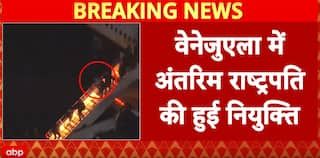Raja Chari-Led SpaceX Crew-3 Mission Lifts Off. All About NASA’s 3rd Crew Rotation Mission To ISS
During their six-month stay aboard the International Space Station, Crew-3 astronauts will conduct science experiments and maintenance activities. They are slated to return to Earth in April 2022.

NASA's SpaceX Crew-3 mission carrying an international crew of four astronauts lifted off to the International Space Station early Thursday on a six-month science expedition. This is NASA's third crew rotation mission to the orbital laboratory, as part of the space agency's Commercial Crew Program.
Who Are The Crew-3 Astronauts?
LIVE: Four astronauts are launching to the @Space_Station on @SpaceX's Crew Dragon!
— NASA (@NASA) November 10, 2021
Our #Crew3 mission is scheduled to lift off from @NASAKennedy at 9:03pm ET (02:03 UTC Nov. 11). Watch with us and send your #askNASA questions: https://t.co/KZST234MYE
NASA astronauts Raja Chari, Thomas Marshburn, and Kayla Barron, and ESA astronaut Matthias Maurer are the crewmembers who blasted off to the space station in a SpaceX Crew Dragon spacecraft named Endurance, atop a Falcon 9 rocket.
Crew-3 mission launched as per schedule on Wednesday, November 10 at 9:03 pm ET (Thursday, November 11 at 7:33 am IST), from Launch Complex 39A at NASA's Kennedy Space Center, Cape Canaveral, Florida.
Raja Chari, the commander of the Crew-3 mission, is responsible for all phases of the flight, from launch to re-entry. He also will serve as an Expedition 66 flight engineer aboard the station. He was selected as a NASA astronaut candidate in 2017. This is his first spaceflight.
Tom Marshburn, the pilot of the Crew Dragon spacecraft and second-in-command for the mission, is responsible for spacecraft systems and performance. He will serve as Expedition 66 flight engineer aboard the ISS, and is scheduled to assume command of station for Expedition 67. Marshburn became an astronaut in 2004.
Kayla Barron, mission specialist for Crew-3, will work closely with the commander and pilot to monitor the spacecraft during the dynamic launch and re-entry phases of flight. She will serve as flight engineer for Expedition 66. This will be her first spaceflight.
Matthias Maurer, mission specialist for Crew-3, will work with the commander and pilot to monitor the spacecraft during the dynamic launch and re-entry phases of flight. He also will become a long-duration crew member aboard the space station. This will be his first trip to space. Upon reaching the space station, Maurer will officially become the 600th person in space.
During their six-month stay aboard the ISS, the Crew-3 astronauts will conduct science experiments and maintenance activities, according to NASA. They are slated to return to Earth in April 2022.
‘Endurance’ Spacecraft And Falcon 9 Rocket
A new Crew Dragon spacecraft is flying the Crew-3 astronauts to the ISS. The Crew-3 mission is be the first to fly a previously used nosecone.
The name "Endurance" was chosen by the Crew-3 astronauts for the spacecraft as a tribute to human enthusiasm for space exploration, be it to low-Earth orbit, or future missions to the Moon and Mars.
The name also acknowledges the efforts of people in the space sector throughout the pandemic, who have made several missions a success, and the people who will fly future-long duration missions in the Endurance spacecraft, NASA said on its website.
The first stage of the Falcon 9 rocket used during SpaceX's 22nd commerical resupply mission to the ISS in June 2021 is being used used for the Crew-3 mission.
Mission Overview
The Falcon 9 rocket will accelerate the Crew Dragon Endurance spacecraft carrying the four astronauts to approximately 17,500 miles per hour.
Endurance is GO for launch 🥳 We're moving ever closer to liftoff at 02:03 GMT/03:03 CET, but there are a few things left to do. Check out this #Infographic for a step-by-step guide. #CountdownToLaunch pic.twitter.com/ewg0K8I8U0
— Human Spaceflight (@esaspaceflight) November 11, 2021
Once Dragon reaches orbit, a series of automatic maneuvers, controlled by the crew and SpaceX mission control, will guide the Crew-3 astronauts to the orbital laboratory, at the forward end of the Harmony Module.
Twenty Two hours after the liftoff, Crew Dragon will dock autonomously into the space station on Wednesday, November 11 at 7:10 pm EST (Thursday, November 12 at 5:40 am IST), NASA said.
The three-member crew of Expedition 66, comprising NASA astronaut Mark Vande Hei, and Russian cosmonauts Pyotr Dubrov and Anton Shkaplerov, will welcome the Crew-3 astronauts on the space station.
The Crew-3 astronauts will conduct scientific research in areas such as material science, health technologies, and plant science to prepare for human exploration beyond low-Earth orbit, and help living beings on Earth.
These experiments include the Fiber Optic Production-2 (FOP-2), the rHEALTH ONE Microgravity Demonstration, the eXposed Root On-Orbit Test System (XROOTS) investigation, and the European Retinal Diagnostics experiment, among others.
FOP-2 builds on previous work to manufacture commerical optical fibers in microgravity, using a blend of elements called ZBLAN, which is a heavy metal fluoride glass.
The health ONE Microgravity Demonstration focuses on flow cytometry, which can provide accurate measurements of biological indicators related to disease, infection, and environmental exposure in microgravity.
The Crew-3 astronauts will use advanced techniques to grow plants without soil or other growth media, as part of the XROOTS investigation.
In the European Retinal Diagnostics experiment, the Crew-3 astronauts will use a commercially available ophthalmology lens to capture images of astronauts' retinas.
At the end of Expedition 66 in early 2022, Shkaplerov, Dubrov, Vande Hei, Chari, Marshburn, Barron, and Maurer will be transferred to Expedition 67.
They will be joined by Roscosmos cosmonauts Oleg Artemyev, Denis Matveev, and Sergey Korsakov in March 2022.
A SpaceX Cargo Dragon and the Northrop Grumman Cygnus will send cargo to the space station in December and early 2022, respectively. Crew-3 astronauts will also welcome two different private crews to the space station.
The Crew-3 astronauts will also conduct a series of spacewalks. They will upgrade the station's power system in a way such that new solar arrays could be installed, to increase the station's total available power supply.
When the mission concludes in spring next year, Crew Dragon, carrying the Crew-3 astronauts, will autonomously undock from the space station, and re-enter the atmosphere, followed by a splashdown off the coast of Florida.





































